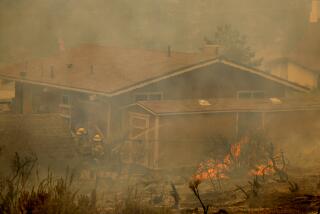Burned-Out New Mexico Town ‘On Its Way Back’
LOS ALAMOS, N.M. — Two years after a government-set wildfire roared out of Los Alamos Canyon and into the town, the banging of hammers and the hum of heavy equipment fills the air.
Houses are springing up from the mud, the construction starkly new against a backdrop of blackened mountainsides.
“Los Alamos is on its way back,” Federal Emergency Management Agency chief Joe Allbaugh said during a recent visit.
More than 350 families lost their homes when the Cerro Grande Fire--named for the peak where the National Park Service began burning brush on May 4, 2000--blew out of the pine forest like a blowtorch.
About 18,000 residents of Los Alamos and nearby White Rock were forced to flee. The fire burned for two months over 43,000 acres, including parts of the Los Alamos National Laboratory, birthplace of the atomic bomb. But it took no lives.
“I was just so grateful the kids were OK, the animals were OK,” recalled Melanie Kossar, mother of two, whose home was destroyed.
Because the fire was the federal government’s fault, FEMA has replaced homes and possessions, repaired damage to houses and property, repaid people for their evacuation costs and their loss of income, and reimbursed businesses for the weeks they were closed.
FEMA also is helping Los Alamos become more fireproof. New houses sport metal roofs, stucco siding, steel doors and tempered glass, at government expense.
Even the new landscaping will be “fire wise.” No more huge combustible ponderosa pines overhanging roofs; instead, swaths of low-growing, fire-resistant shrubs or plants, and noncombustible rock and mulches, will surround new homes.
Community fireproofing efforts--tree-thinning, for example--will be paid for by FEMA in Los Alamos and neighboring areas.
The projected price tag for the claims and prevention efforts: $535million.
The disaster agency’s usual role is providing temporary assistance, helping victims get back on their feet with grants or low-interest loans.
Only once before has the federal government compensated victims for all their losses, FEMA said. That was in 1976, after the Bureau of Reclamation’s Teton Dam in Idaho gave way, killing 11 and destroying 130 homes in the little farm town below.
Kossar, underinsured and newly divorced at the time of the fire, said that without government help she would have been in serious trouble after the multifamily house she lived in burned to the ground.
For the last two years, she has been living with her 18-year-old son and 16-year-old daughter in a FEMA trailer.
She hopes to return by the end of this month to her former neighborhood, but to a house of her own. The wooden unit called a “quad,” built decades ago by the government for laboratory workers, is being replaced by three single-family homes.
In the mobile home in “FEMAville”--the temporary trailer park that initially housed 85 families and is down to 18--”there’s no way to get away from each other. Here, the kids can have their own rooms,” Kossar said, showing off the small two-story home.
And she’ll have the same next-door neighbors.
“We liked the neighborhood and we wanted to come back,” said Charlene McHale, who bought into the quad only six months before the fire.
McHale, the mother of two grown children, also was newly divorced when she moved to the quad, an experience she says made her and Kossar more resilient.
“We kind of knew the process to get on with it. You just try to put one foot in front of the other and keep going,” McHale said.
The federal government also is providing Los Alamos County with $30million for other mitigation measures, including burying utilities in burned neighborhoods, thinning trees and removing dead wood on county-owned land, and helping homeowners who weren’t burned out to make their places more fire resistant.
“The fence line that separates the public land from the private land doesn’t stop a fire,” said Bruce Irwin, the county’s mitigation projects coordinator.
Los Alamos, located atop a 7,300-foot mesa in the Jemez Mountains, abuts a ponderosa pine forest.
“There are hundreds of mountain communities around the U.S. that have the same problem,” Irwin said.
Los Alamos homeowners, beginning with those in high-risk areas on the forest-fringed perimeter of town, will be able to for reimbursement of as much as $2,500 for creating “defensible space” around their homes, Irwin said.
More to Read
Sign up for Essential California
The most important California stories and recommendations in your inbox every morning.
You may occasionally receive promotional content from the Los Angeles Times.










